Rick Just's Blog, page 133
March 9, 2021
Critters Attracting Tourists
This is another of our occasional Now and Then features.
THEN:
In 1868 Joseph Rich owned a spa on Bear Lake in the southeast corner of Idaho. He wrote to the Deseret News in Salt Lake City and told a story he said he'd heard from local Indians. According to their legends, a serpentine monster prowled Bear Lake. It had short, stubby legs it sometimes used to scurry onto shore and snatch away maidens in its terrible jaws.
After the letter appeared, people all over the valley began seeing the monster. One said it was 40 feet long and swam faster than a horse could run. Another claimed it was 90 feet long and swam faster than a locomotive.
This astonishing creature had everyone in an uproar.
The Salt Lake newspaper carried many accounts of monster sightings, and efforts to trap the beast.
Then, Joseph Rich wrote another letter to the paper expressing his sorrow that some didn't believe in the monster. He said, "they might come up here someday, and through their unbelief, be thrown off their guard and gobbled up by the Water Devil." There was a tone to that letter though, that not everyone caught. Mr. Rich was writing tongue in cheek and having a wonderful time with the tale he had invented to attract customers to his resort.
Many more people claimed to have spotted the Bear Lake Monster over the years, and they started seeing monsters in other nearby lakes... which must have been an endless source of amusement for the monster's father, Joseph Rich.
NOW:
Other entrepreneurs are using a mythical creature to attract tourists today. Francis Conklin and Dennis Sullivan are husband and wife artists who live in Cottonwood. They had great success in 1995 when their chainsaw carvings of dogs were featured on QVC. They had to work like—sorry—dogs to keep up with the orders.
Their studio and shop are near the highway as it passes by Cottonwood. To draw people in, they carved up the “world’s biggest beagle” and parked it out front. That worked so well that they had another big idea. How about a dog big enough that you could sleep in it?
Dennis and Francis built the 30-foot high, two-bedroom beagle and started booking reservations at Dog Bark Park Inn. It drew tourists off the highway, all right, but the big dog’s fame grew in other ways. The beagle, which also has a balcony, has been featured in dozens of magazines, blogs, videos, etc. To name a few, O Magazine, the Ellen DeGeneres Show, the Washington Post, LA Times, CNN, and on and on.
They have at least as much fun with their invention as Joseph Rich did with his 127 years earlier.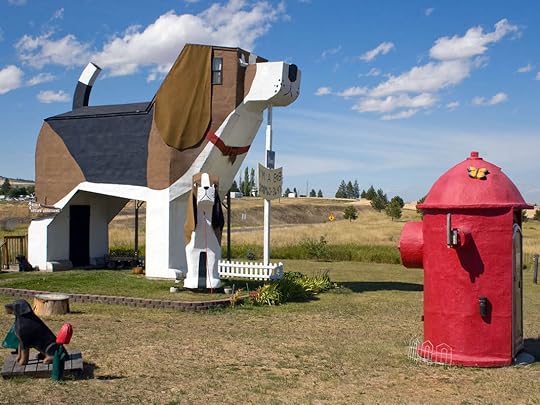 The big beagle, "Sweet Willie," at Dog Bark Park in Cottonwood. We're fresh out of pictures of the Bear Lake monster.
The big beagle, "Sweet Willie," at Dog Bark Park in Cottonwood. We're fresh out of pictures of the Bear Lake monster.
THEN:
In 1868 Joseph Rich owned a spa on Bear Lake in the southeast corner of Idaho. He wrote to the Deseret News in Salt Lake City and told a story he said he'd heard from local Indians. According to their legends, a serpentine monster prowled Bear Lake. It had short, stubby legs it sometimes used to scurry onto shore and snatch away maidens in its terrible jaws.
After the letter appeared, people all over the valley began seeing the monster. One said it was 40 feet long and swam faster than a horse could run. Another claimed it was 90 feet long and swam faster than a locomotive.
This astonishing creature had everyone in an uproar.
The Salt Lake newspaper carried many accounts of monster sightings, and efforts to trap the beast.
Then, Joseph Rich wrote another letter to the paper expressing his sorrow that some didn't believe in the monster. He said, "they might come up here someday, and through their unbelief, be thrown off their guard and gobbled up by the Water Devil." There was a tone to that letter though, that not everyone caught. Mr. Rich was writing tongue in cheek and having a wonderful time with the tale he had invented to attract customers to his resort.
Many more people claimed to have spotted the Bear Lake Monster over the years, and they started seeing monsters in other nearby lakes... which must have been an endless source of amusement for the monster's father, Joseph Rich.
NOW:
Other entrepreneurs are using a mythical creature to attract tourists today. Francis Conklin and Dennis Sullivan are husband and wife artists who live in Cottonwood. They had great success in 1995 when their chainsaw carvings of dogs were featured on QVC. They had to work like—sorry—dogs to keep up with the orders.
Their studio and shop are near the highway as it passes by Cottonwood. To draw people in, they carved up the “world’s biggest beagle” and parked it out front. That worked so well that they had another big idea. How about a dog big enough that you could sleep in it?
Dennis and Francis built the 30-foot high, two-bedroom beagle and started booking reservations at Dog Bark Park Inn. It drew tourists off the highway, all right, but the big dog’s fame grew in other ways. The beagle, which also has a balcony, has been featured in dozens of magazines, blogs, videos, etc. To name a few, O Magazine, the Ellen DeGeneres Show, the Washington Post, LA Times, CNN, and on and on.
They have at least as much fun with their invention as Joseph Rich did with his 127 years earlier.
 The big beagle, "Sweet Willie," at Dog Bark Park in Cottonwood. We're fresh out of pictures of the Bear Lake monster.
The big beagle, "Sweet Willie," at Dog Bark Park in Cottonwood. We're fresh out of pictures of the Bear Lake monster.
Published on March 09, 2021 04:30
March 8, 2021
The Tallest Dam
Arrowrock Dam may not seem like an engineering marvel, but it was the tallest dam in the world at one time. It didn’t hold that distinction for long. At 348, 350, or 351 feet—different writers used different rulers, apparently—it held that title from 1915 until 1932 when the Owyhee Dam in Oregon knocked it off its pedestal by about 50 feet.
The postcard below trumpeted the dam’s status by calling it the “highest dam.” I don’t know what dam would be the highest in the world, since “highest” refers to elevation. In Idaho the dam at the highest elevation would probably be Palisades Dam. Anyway, they meant tallest.
Arrowrock doesn’t even make the Wikipedia list of tall dams today. The tallest on that list is the Jinping Dam in China, at 1,001 feet.
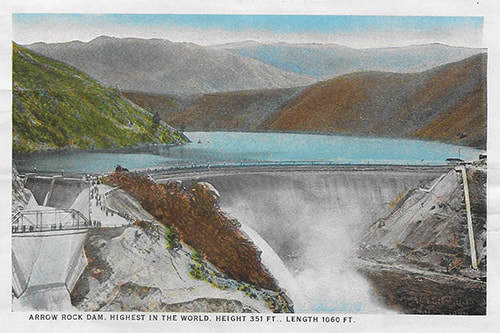 Above is a postcard of Arrowrock in its glory days. Below is the dam under construction in 1912.
Above is a postcard of Arrowrock in its glory days. Below is the dam under construction in 1912. 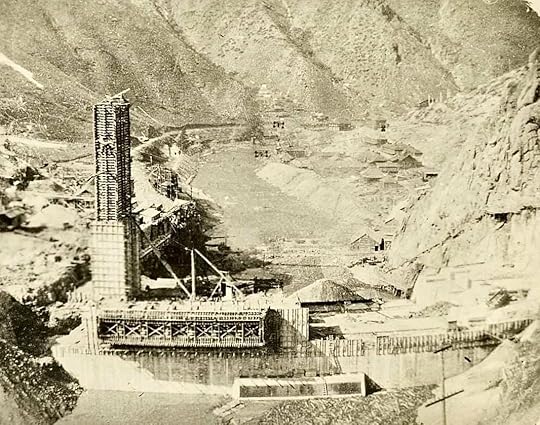
The postcard below trumpeted the dam’s status by calling it the “highest dam.” I don’t know what dam would be the highest in the world, since “highest” refers to elevation. In Idaho the dam at the highest elevation would probably be Palisades Dam. Anyway, they meant tallest.
Arrowrock doesn’t even make the Wikipedia list of tall dams today. The tallest on that list is the Jinping Dam in China, at 1,001 feet.
 Above is a postcard of Arrowrock in its glory days. Below is the dam under construction in 1912.
Above is a postcard of Arrowrock in its glory days. Below is the dam under construction in 1912. 
Published on March 08, 2021 04:00
March 7, 2021
"Big Ed" Sanders
“Big Ed” Sanders led a meteoric life. Born in 1930 in the Watts neighborhood of Los Angles, he was a standout in track and field as well as football at Jordan High School. Compton Junior College recruited the 6-foot-4, 220-pound high school senior to play football. It was at Compton where he learned to box.
Hayes Edward Sanders was at the 1950 National Junior College Boxing Championships in Ogden, Utah when Idaho State College boxing coach Dubby Holt spotted him.
Holt, for whom Holt Arena at Idaho State University is named, led a boxing program that was getting national attention. “Big Ed,” who had won the NCAA Junior Championship in 1949 and 1950, jumped at the chance to box for ISC.
A young man by the name of Jake LaRue picked Sanders up at the train station. “Big Ed” would soon marry Jake’s sister, Mary, who worked in the ISC athletic department. Things happened fast in Sander’s life.
“Big Ed” knocked out the Pacific Coast Heavyweight Champion in his first fight for the college. He continued for a little over a year, setting a record by never losing a bout in a college dual meet.
In 1951 the Korean War was the big fight the country was most interested in. Sanders got drafted. Holt advised him to enlist so he could join the U.S. Navy Boxing Team. He did so and proceeded to beat the Navy Heavyweight Champion and burn through a series of Golden Gloves tournaments.
In 1952, “Big Ed” Sanders qualified for the summer Olympic games. His first three opponents were no match for him. The fight for the gold was with Ingemar Johansson who would later become the World Heavyweight Champion. Johansson was less trouble for Sanders than the previous fights. The Swedish boxer was disqualified in the second round for largely avoiding contact with Sanders.
“Big Ed” Sanders became the first African American Olympic Heavyweight champion. The City of Los Angeles named a day in his honor. The media loved the humble big man, constantly asking for interviews. He turned pro in 1953. It was the logical next step for such a gifted fighter, and with a new son at home, he needed the money. But boxing is not a gentle sport. On December 12, 1954 Sanders fought the New England Heavyweight Champion, Willie James. In round 11 James threw a flurry of punches that knocked Sanders down. He would not get up again.
Sanders died at age 24, leaving behind his wife Mary and their 17-month-old son, Russel. He was inducted into the Idaho State College Athletic Hall of Fame. In 2012 Sanders was also inducted into the Compton Community College Athletics Hall of Fame.
Thanks to Idaho State Journal writer Jason Enes for his story on Sanders in 2012, from which much of the information for this post was gleaned.
 Sanders (right) against Jack Scheberies during the American Olympic Boxing Championships in June 1952
Sanders (right) against Jack Scheberies during the American Olympic Boxing Championships in June 1952
Hayes Edward Sanders was at the 1950 National Junior College Boxing Championships in Ogden, Utah when Idaho State College boxing coach Dubby Holt spotted him.
Holt, for whom Holt Arena at Idaho State University is named, led a boxing program that was getting national attention. “Big Ed,” who had won the NCAA Junior Championship in 1949 and 1950, jumped at the chance to box for ISC.
A young man by the name of Jake LaRue picked Sanders up at the train station. “Big Ed” would soon marry Jake’s sister, Mary, who worked in the ISC athletic department. Things happened fast in Sander’s life.
“Big Ed” knocked out the Pacific Coast Heavyweight Champion in his first fight for the college. He continued for a little over a year, setting a record by never losing a bout in a college dual meet.
In 1951 the Korean War was the big fight the country was most interested in. Sanders got drafted. Holt advised him to enlist so he could join the U.S. Navy Boxing Team. He did so and proceeded to beat the Navy Heavyweight Champion and burn through a series of Golden Gloves tournaments.
In 1952, “Big Ed” Sanders qualified for the summer Olympic games. His first three opponents were no match for him. The fight for the gold was with Ingemar Johansson who would later become the World Heavyweight Champion. Johansson was less trouble for Sanders than the previous fights. The Swedish boxer was disqualified in the second round for largely avoiding contact with Sanders.
“Big Ed” Sanders became the first African American Olympic Heavyweight champion. The City of Los Angeles named a day in his honor. The media loved the humble big man, constantly asking for interviews. He turned pro in 1953. It was the logical next step for such a gifted fighter, and with a new son at home, he needed the money. But boxing is not a gentle sport. On December 12, 1954 Sanders fought the New England Heavyweight Champion, Willie James. In round 11 James threw a flurry of punches that knocked Sanders down. He would not get up again.
Sanders died at age 24, leaving behind his wife Mary and their 17-month-old son, Russel. He was inducted into the Idaho State College Athletic Hall of Fame. In 2012 Sanders was also inducted into the Compton Community College Athletics Hall of Fame.
Thanks to Idaho State Journal writer Jason Enes for his story on Sanders in 2012, from which much of the information for this post was gleaned.
 Sanders (right) against Jack Scheberies during the American Olympic Boxing Championships in June 1952
Sanders (right) against Jack Scheberies during the American Olympic Boxing Championships in June 1952
Published on March 07, 2021 04:00
March 6, 2021
A Famous Pianist
Louis Jacob Weertz came to Idaho in 1943. He was one of almost 300,000 men who trained for World War II at Farragut Naval Training Station, where Farragut State Park is now. He played piano well even then, but at Farragut, he was probably best known for his boxing. Weertz was the welterweight champion boxer on the base.
Weertz was one of a handful of Farragut recruits who received part of their training at what was then the University of Idaho Southern Branch in Pocatello. He must have liked the city, because he came back after the war to attend college. He received a BA in music from ISU, then went on to get a Master's from Drake University. He studied further at Julliard in New York.
For whatever reason, Weertz decided to change his name while living in Pocatello. He allegedly pulled out a telephone book and ran his finger down the columns until he found one he liked. That name was Roger Williams.
There was only one Roger Williams in the phonebook at that time, according to the Roger Williams I knew. My friend, Roger, was a long-time Fish and Game employee and gained some measure of fame, along with Syd Tate, by charting out Idaho’s Centennial Trail.
The faux or, perhaps better-said, newly named Roger Williams gained quite a bit of fame in his time.
First, he won "Arthur Godfrey's Talent Scouts" program, with a lively piano rendition of I Got Rhythm. But it wasn't until 1954, that a record company executive heard him playing piano in a Manhattan cocktail lounge, and signed him to a contract. His first, and still most famous, hit record was Autumn Leaves. By 1968 he had recorded 52 albums, and sold nearly 15 million records. At 43, he became the best-selling instrumentalist of all time.
Roger Williams, name borrower, Farragut Naval Training Station recruit, ISU graduate, and world renowned pianist and composer passed away in 2011.
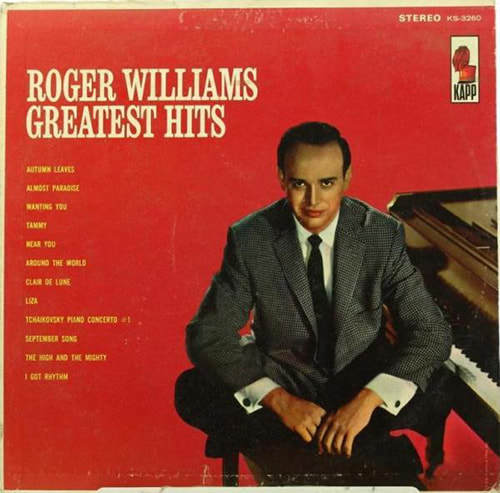
Weertz was one of a handful of Farragut recruits who received part of their training at what was then the University of Idaho Southern Branch in Pocatello. He must have liked the city, because he came back after the war to attend college. He received a BA in music from ISU, then went on to get a Master's from Drake University. He studied further at Julliard in New York.
For whatever reason, Weertz decided to change his name while living in Pocatello. He allegedly pulled out a telephone book and ran his finger down the columns until he found one he liked. That name was Roger Williams.
There was only one Roger Williams in the phonebook at that time, according to the Roger Williams I knew. My friend, Roger, was a long-time Fish and Game employee and gained some measure of fame, along with Syd Tate, by charting out Idaho’s Centennial Trail.
The faux or, perhaps better-said, newly named Roger Williams gained quite a bit of fame in his time.
First, he won "Arthur Godfrey's Talent Scouts" program, with a lively piano rendition of I Got Rhythm. But it wasn't until 1954, that a record company executive heard him playing piano in a Manhattan cocktail lounge, and signed him to a contract. His first, and still most famous, hit record was Autumn Leaves. By 1968 he had recorded 52 albums, and sold nearly 15 million records. At 43, he became the best-selling instrumentalist of all time.
Roger Williams, name borrower, Farragut Naval Training Station recruit, ISU graduate, and world renowned pianist and composer passed away in 2011.

Published on March 06, 2021 04:00
March 5, 2021
Idaho's Flying Saucer Man
Individual Idahoans are responsible for many things we take for granted today, from TV to Teflon. Oh, and flying saucers, of course.
It was Tuesday, June 24th, 1947. Boise businessman Kenneth Arnold was flying near Mt. Rainier in Washington State, looking for a downed Marine Corps transport plane. Arnold, an experienced pilot, saw something in the fading sunlight that he had never seen before.
At an altitude of 9,200 feet he spotted a chain of objects weaving in the air, one after another. For a moment, he thought it might be a formation of geese--but at that altitude? Then he saw the sun reflect from the objects, suggesting that they might be metal.
The nine objects didn't seem to be airplanes, though. They had no wings; no tail fins. A drawing Arnold made of one object looks like the shape a windshield wiper would leave arcing through raindrops. That shape caught the imagination of the country. Other reports came in from across the nation--reports of "flying saucers."
The term "flying saucers" came from that sighting of unidentified flying objects. The modern age of UFOs began on that evening in 1947 when Boisean Kenneth Arnold, looking for a downed aircraft, saw something strange, instead.
The sighting gave Arnold a degree of fame he never sought. He became something of a celebrity among UFO buffs, and was the featured speaker when the first International UFO Congress met in 1977. He died a few years later, never certain of what he saw, but certain he saw something. Kenneth Arnold with a drawing of what he saw.
Kenneth Arnold with a drawing of what he saw.
It was Tuesday, June 24th, 1947. Boise businessman Kenneth Arnold was flying near Mt. Rainier in Washington State, looking for a downed Marine Corps transport plane. Arnold, an experienced pilot, saw something in the fading sunlight that he had never seen before.
At an altitude of 9,200 feet he spotted a chain of objects weaving in the air, one after another. For a moment, he thought it might be a formation of geese--but at that altitude? Then he saw the sun reflect from the objects, suggesting that they might be metal.
The nine objects didn't seem to be airplanes, though. They had no wings; no tail fins. A drawing Arnold made of one object looks like the shape a windshield wiper would leave arcing through raindrops. That shape caught the imagination of the country. Other reports came in from across the nation--reports of "flying saucers."
The term "flying saucers" came from that sighting of unidentified flying objects. The modern age of UFOs began on that evening in 1947 when Boisean Kenneth Arnold, looking for a downed aircraft, saw something strange, instead.
The sighting gave Arnold a degree of fame he never sought. He became something of a celebrity among UFO buffs, and was the featured speaker when the first International UFO Congress met in 1977. He died a few years later, never certain of what he saw, but certain he saw something.
 Kenneth Arnold with a drawing of what he saw.
Kenneth Arnold with a drawing of what he saw.
Published on March 05, 2021 04:00
March 4, 2021
The Crashes of 1966
1966 was going to be a pivotal election year no matter what. The Idaho Legislature had passed the 3-cent sales tax and Governor Robert E. Smylie had signed the bill. State Senator Don Samuelson, Sandpoint, was challenging the governor in the Republican primary based at least in part on Smylie’s support of the sales tax. The Democratic primary pitted a former Idaho state senator, Charles Herndon from Salmon, against Idaho State Senator Cecil Andrus, from Orofino.
Sales tax was a divisive issue, almost as divisive as the Viet Nam War was becoming. But airplanes would change the course of that year’s election as much as issues.
First, a leading contender for the Republican nomination for Congress from Idaho’s First Congressional District crashed his airplane near Osburn. John N. Mattmiller, who had run unsuccessfully for the seat in 1964, was piloting his four-place Piper Comanche over North Idaho’s Silver Valley when the crash happened. An experienced pilot, Mattmiller had survived a crash five years earlier that had broken both legs.
According to witnesses, the Comanche dropped out of the overcast into the narrow valley, apparently looking for a place to land. Mattmiller narrowly missed the KWAL radio tower in Osburn. The plane seemed to be headed for a landing on U.S. 10, about five miles from his destination at the Smelterville airport. Mattmiller pulled up when he saw a tanker truck on the highway, and banked the plane around, perhaps for another landing attempt. That’s when he struck a powerline, bringing the plane down hard. Mattmiller, and a passenger both died instantly.
Mattmiller’s untimely death opened up the primary for a young state senator named Jim McClure. McClure was elected to Congress and served in the House of Representatives until 1973 when he was elected to the U.S. Senate. He served there until his retirement in 1991.
In the primary for governor, Samuelson surprised Smylie, defeating the long-serving governor soundly. Herndon sneaked by Cecil Andrus by about 1,300 votes setting up a general election bout with Samuelson.
Then came the second crash. On September 14, 1966, Herndon was in Pocatello looking for a flight to Coeur d’Alene where he had an afternoon speaking engagement. Nothing commercial was flying because the Pocatello and Idaho Falls airports were socked in with fog.
Herndon made a highway dash for Twin Falls where he chartered an airplane. Two men from Oklahoma City who had business in North Idaho shared the charter with Herndon.
Herndon and the pilot, Bill Bir of Twin Falls, were in the front seats of the Piper Apache. Oddly, when the plane came out of the clouds and plowed into a forested hillside ten miles west of Stanley, the Oklahoma passengers in back were killed instantly. Herndon and the pilot were badly injured. The pilot was airlifted from the crash site to a Sun Valley hospital. He survived. Charles Herndon died before he could be taken from the crash site.
The runner-up in the Democratic primary was named to replace Herndon on the ticket. That was the first time Cecil D. Andrus faced Don Samuelson. Samuelson won the first match, becoming Idaho’s 25th governor. Four years later, Andrus would become the 26th governor of Idaho, defeating Samuelson. He would eventually win four elections to that post and become Secretary of the Interior in President Jimmy Carter’s cabinet.

Sales tax was a divisive issue, almost as divisive as the Viet Nam War was becoming. But airplanes would change the course of that year’s election as much as issues.
First, a leading contender for the Republican nomination for Congress from Idaho’s First Congressional District crashed his airplane near Osburn. John N. Mattmiller, who had run unsuccessfully for the seat in 1964, was piloting his four-place Piper Comanche over North Idaho’s Silver Valley when the crash happened. An experienced pilot, Mattmiller had survived a crash five years earlier that had broken both legs.
According to witnesses, the Comanche dropped out of the overcast into the narrow valley, apparently looking for a place to land. Mattmiller narrowly missed the KWAL radio tower in Osburn. The plane seemed to be headed for a landing on U.S. 10, about five miles from his destination at the Smelterville airport. Mattmiller pulled up when he saw a tanker truck on the highway, and banked the plane around, perhaps for another landing attempt. That’s when he struck a powerline, bringing the plane down hard. Mattmiller, and a passenger both died instantly.
Mattmiller’s untimely death opened up the primary for a young state senator named Jim McClure. McClure was elected to Congress and served in the House of Representatives until 1973 when he was elected to the U.S. Senate. He served there until his retirement in 1991.
In the primary for governor, Samuelson surprised Smylie, defeating the long-serving governor soundly. Herndon sneaked by Cecil Andrus by about 1,300 votes setting up a general election bout with Samuelson.
Then came the second crash. On September 14, 1966, Herndon was in Pocatello looking for a flight to Coeur d’Alene where he had an afternoon speaking engagement. Nothing commercial was flying because the Pocatello and Idaho Falls airports were socked in with fog.
Herndon made a highway dash for Twin Falls where he chartered an airplane. Two men from Oklahoma City who had business in North Idaho shared the charter with Herndon.
Herndon and the pilot, Bill Bir of Twin Falls, were in the front seats of the Piper Apache. Oddly, when the plane came out of the clouds and plowed into a forested hillside ten miles west of Stanley, the Oklahoma passengers in back were killed instantly. Herndon and the pilot were badly injured. The pilot was airlifted from the crash site to a Sun Valley hospital. He survived. Charles Herndon died before he could be taken from the crash site.
The runner-up in the Democratic primary was named to replace Herndon on the ticket. That was the first time Cecil D. Andrus faced Don Samuelson. Samuelson won the first match, becoming Idaho’s 25th governor. Four years later, Andrus would become the 26th governor of Idaho, defeating Samuelson. He would eventually win four elections to that post and become Secretary of the Interior in President Jimmy Carter’s cabinet.

Published on March 04, 2021 04:00
March 3, 2021
The First Streamliner
People coming from miles around to get a glimpse of a special train is nothing new. Since steam locomotives were discontinued decades ago, the arrival of one in an Idaho town always draws a crowd. But what if steam was the rule and internal combustion the rarity?
On April 4, 1934, it was an internal combustion locomotive causing a stir with people flocking to see the first streamliner, the Union Pacific M-10000 as it passed through Idaho on its nationwide promotional tour. All along the route from Pocatello to Idaho Falls people stopped to watch the locomotive zip by at 85 miles per hour. Several car drivers raced to try keeping up with the engine on the parallel US 91-191. Bands came out to play for the train in Blackfoot and Shelley.
W. Averell Harriman—who would later develop the Sun Valley Resort for Union Pacific—had the train built, incorporating the best ideas of aeronautical design and the latest railroad technology. It was built with lightweight tubular aluminum construction and was powered by a spark-ignition distillate engine, using a lightweight fuel something like kerosene. It could reach speeds up to 110 MPH.
The M-10000 wasn’t just a prototype, although a second one never was built. The engine was put into service and operated almost a million miles under the name City of Salina before being retired, cut to pieces and recycled for the war effort in 1942. The M-1000, later known as the City of Salina.
The M-1000, later known as the City of Salina. 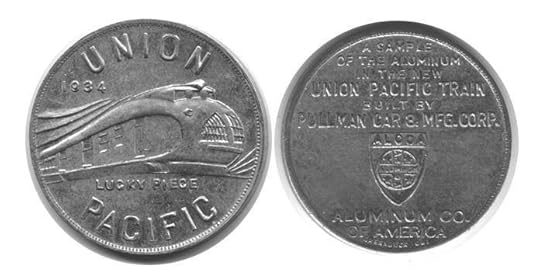 Commemorative token minted to celebrate the M-1000.
Commemorative token minted to celebrate the M-1000.
On April 4, 1934, it was an internal combustion locomotive causing a stir with people flocking to see the first streamliner, the Union Pacific M-10000 as it passed through Idaho on its nationwide promotional tour. All along the route from Pocatello to Idaho Falls people stopped to watch the locomotive zip by at 85 miles per hour. Several car drivers raced to try keeping up with the engine on the parallel US 91-191. Bands came out to play for the train in Blackfoot and Shelley.
W. Averell Harriman—who would later develop the Sun Valley Resort for Union Pacific—had the train built, incorporating the best ideas of aeronautical design and the latest railroad technology. It was built with lightweight tubular aluminum construction and was powered by a spark-ignition distillate engine, using a lightweight fuel something like kerosene. It could reach speeds up to 110 MPH.
The M-10000 wasn’t just a prototype, although a second one never was built. The engine was put into service and operated almost a million miles under the name City of Salina before being retired, cut to pieces and recycled for the war effort in 1942.
 The M-1000, later known as the City of Salina.
The M-1000, later known as the City of Salina.  Commemorative token minted to celebrate the M-1000.
Commemorative token minted to celebrate the M-1000.
Published on March 03, 2021 04:00
March 2, 2021
Not a Fan of Public Lands
Idaho’s first state park, designated in 1908, owes its existence to this man, U.S. Senator (1903-1912) Weldon B. Heyburn. He was a staunch opponent of federal public lands and was an early foil of the newly formed Forest Service in the early part of the 20th Century.
Still, he wanted one national park in Idaho to be created from Coeur d’Alene Tribal land that was being disposed of, without enthusiasm from the Coeur d’Alenes. He once famously said that state parks were “always an embarrassment.” So, he fought to make the area near St. Maries a national park. He lost. Congress instead authorized the sale of the site to the state of Idaho. The state of Idaho cut enough timber in the park to pay the asking price, then honored the man who thought state parks were always an embarrassment by naming it after Sen. Heyburn.
There are a couple of other things named after the senator, the town of Heyburn, Idaho, and 10,229-foot Mount Heyburn in the Sawtooth range, about eight miles from Stanley. That the mountain and the park are both named after a man who spent much of his political career fighting against public lands galls some conservationists.
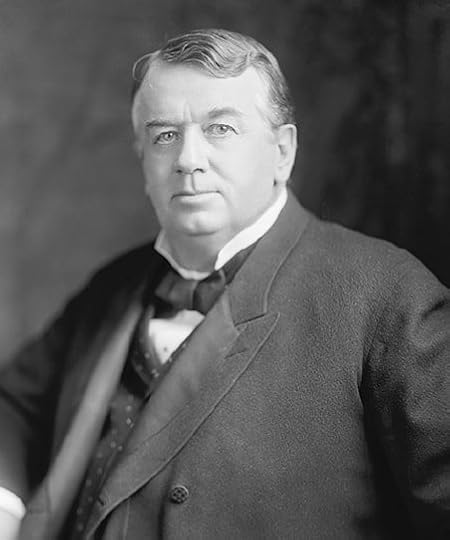 Weldon B. Heyburn
Weldon B. Heyburn
Still, he wanted one national park in Idaho to be created from Coeur d’Alene Tribal land that was being disposed of, without enthusiasm from the Coeur d’Alenes. He once famously said that state parks were “always an embarrassment.” So, he fought to make the area near St. Maries a national park. He lost. Congress instead authorized the sale of the site to the state of Idaho. The state of Idaho cut enough timber in the park to pay the asking price, then honored the man who thought state parks were always an embarrassment by naming it after Sen. Heyburn.
There are a couple of other things named after the senator, the town of Heyburn, Idaho, and 10,229-foot Mount Heyburn in the Sawtooth range, about eight miles from Stanley. That the mountain and the park are both named after a man who spent much of his political career fighting against public lands galls some conservationists.
 Weldon B. Heyburn
Weldon B. Heyburn
Published on March 02, 2021 04:00
March 1, 2021
The Hemingway Cats
Give me one word that you associate with Ernest Hemingway. Writer? Outdoorsman? Fishing? Hunting?
How about, cats? If you look hard enough you can find a picture of Hemingway with a hunting dog, but you'll find many pictures of him with his cats or just pictures of his cats. Here are a few I thought you might enjoy. Ernest Hemingway’s cat Big Boy Peterson sits among papers in front of a window with a view of Bald Mountain at Hemingway’s home in Ketchum, Idaho, undated. Ernest Hemingway Photographs Collection. John F. Kennedy Presidential Library and Museum, Boston.
Ernest Hemingway’s cat Big Boy Peterson sits among papers in front of a window with a view of Bald Mountain at Hemingway’s home in Ketchum, Idaho, undated. Ernest Hemingway Photographs Collection. John F. Kennedy Presidential Library and Museum, Boston.  Ernest Hemingway and his cat, Boise, outside his home, Finca Vigia, in Cuba. Ernest Hemingway Photographs Collection, John F. Kennedy Presidential Library and Museum, Boston.
Ernest Hemingway and his cat, Boise, outside his home, Finca Vigia, in Cuba. Ernest Hemingway Photographs Collection, John F. Kennedy Presidential Library and Museum, Boston. 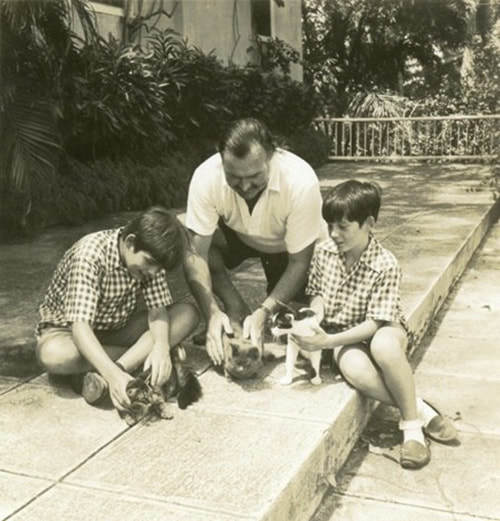 Patrick “Mouse” Hemingway, Ernest Hemingway, and Gregory “Gigi” Hemingway with three cats (Good Will, Princessa, and Boise) at Finca Vigia, Cuba, November 1946. Ernest Hemingway Photograph Collection, John F. Kennedy Presidential Library.
Patrick “Mouse” Hemingway, Ernest Hemingway, and Gregory “Gigi” Hemingway with three cats (Good Will, Princessa, and Boise) at Finca Vigia, Cuba, November 1946. Ernest Hemingway Photograph Collection, John F. Kennedy Presidential Library. 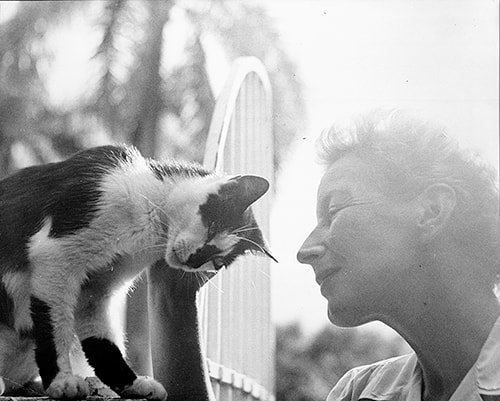 Mary Hemingway with cat, Boise. Finca Vigia, San Francisco de Paula, Cuba. Ernest Hemingway Photograph Collection, John F. Kennedy Presidential Library.
Mary Hemingway with cat, Boise. Finca Vigia, San Francisco de Paula, Cuba. Ernest Hemingway Photograph Collection, John F. Kennedy Presidential Library.
 A whole lot of cats with Mary Welsh Hemingway in the doorway. Ernest Hemingway Photograph Collection, John F. Kennedy Presidential Library.
A whole lot of cats with Mary Welsh Hemingway in the doorway. Ernest Hemingway Photograph Collection, John F. Kennedy Presidential Library.
How about, cats? If you look hard enough you can find a picture of Hemingway with a hunting dog, but you'll find many pictures of him with his cats or just pictures of his cats. Here are a few I thought you might enjoy.
 Ernest Hemingway’s cat Big Boy Peterson sits among papers in front of a window with a view of Bald Mountain at Hemingway’s home in Ketchum, Idaho, undated. Ernest Hemingway Photographs Collection. John F. Kennedy Presidential Library and Museum, Boston.
Ernest Hemingway’s cat Big Boy Peterson sits among papers in front of a window with a view of Bald Mountain at Hemingway’s home in Ketchum, Idaho, undated. Ernest Hemingway Photographs Collection. John F. Kennedy Presidential Library and Museum, Boston.  Ernest Hemingway and his cat, Boise, outside his home, Finca Vigia, in Cuba. Ernest Hemingway Photographs Collection, John F. Kennedy Presidential Library and Museum, Boston.
Ernest Hemingway and his cat, Boise, outside his home, Finca Vigia, in Cuba. Ernest Hemingway Photographs Collection, John F. Kennedy Presidential Library and Museum, Boston.  Patrick “Mouse” Hemingway, Ernest Hemingway, and Gregory “Gigi” Hemingway with three cats (Good Will, Princessa, and Boise) at Finca Vigia, Cuba, November 1946. Ernest Hemingway Photograph Collection, John F. Kennedy Presidential Library.
Patrick “Mouse” Hemingway, Ernest Hemingway, and Gregory “Gigi” Hemingway with three cats (Good Will, Princessa, and Boise) at Finca Vigia, Cuba, November 1946. Ernest Hemingway Photograph Collection, John F. Kennedy Presidential Library.  Mary Hemingway with cat, Boise. Finca Vigia, San Francisco de Paula, Cuba. Ernest Hemingway Photograph Collection, John F. Kennedy Presidential Library.
Mary Hemingway with cat, Boise. Finca Vigia, San Francisco de Paula, Cuba. Ernest Hemingway Photograph Collection, John F. Kennedy Presidential Library.
 A whole lot of cats with Mary Welsh Hemingway in the doorway. Ernest Hemingway Photograph Collection, John F. Kennedy Presidential Library.
A whole lot of cats with Mary Welsh Hemingway in the doorway. Ernest Hemingway Photograph Collection, John F. Kennedy Presidential Library.
Published on March 01, 2021 04:00
February 28, 2021
Pop Quiz
Below is a little Idaho trivia quiz. If you’ve been following Speaking of Idaho, you might do very well. Caution, it is my job to throw you off the scent. Answers below the picture. If you missed that story, click the letter for a link.
1). What Idaho mountain did everyone thing was the highest in the state before 1934?
A. Mount Borah
B. Half Dome
C. Mount Heyburn
D. Hyndman Peak
E. He Devil Peak
2). What was the name of the 1952 song about the Idaho State Fair?
A. Here We Have Idaho
B. An Idaho Rodeo
C. State Fair
D. Love on the Midway
E. Idaho State Fair
3). What type of music was the 1941 song “Idaho?”
A. March
B. Jazz
C. Polka
D. Waltz
E. Country and Western
4). Who was the last governor to occupy Idaho’s Governor’s “Mansion?”
A. Robert E. Smylie
B. Len B. Jordon
C. John Evans
D. Cecil D. Andrus
E. Don Samuelson
5) If you have a stamp from KSEI because of your hobby, what might you be called?
A. DXer
B. Numismatic
C. Pannapictagraphist
D. Audiophile
E. Oenophile
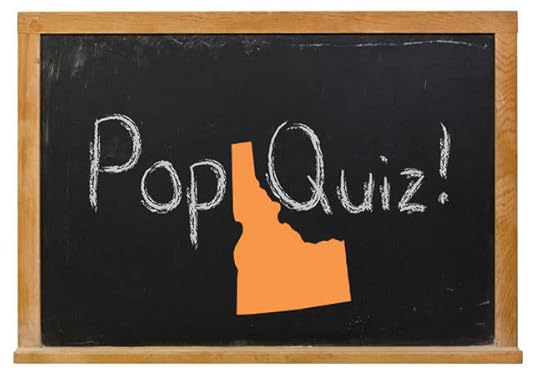 Answers (If you missed that story, click the letter for a link)
Answers (If you missed that story, click the letter for a link)
1, D
2, E
3, B
4, C
5, A
How did you do?
5 right—Why aren’t you writing this blog?
4 right—A true Idaho native, no matter where you’re from.
3 right—Good! Treat yourself to some French fries.
2 right—Okay! Eat more potatoes!
1 right—Meh. You need to read more blog posts.
0 right—Really, you should reconsider your recent relocation.
1). What Idaho mountain did everyone thing was the highest in the state before 1934?
A. Mount Borah
B. Half Dome
C. Mount Heyburn
D. Hyndman Peak
E. He Devil Peak
2). What was the name of the 1952 song about the Idaho State Fair?
A. Here We Have Idaho
B. An Idaho Rodeo
C. State Fair
D. Love on the Midway
E. Idaho State Fair
3). What type of music was the 1941 song “Idaho?”
A. March
B. Jazz
C. Polka
D. Waltz
E. Country and Western
4). Who was the last governor to occupy Idaho’s Governor’s “Mansion?”
A. Robert E. Smylie
B. Len B. Jordon
C. John Evans
D. Cecil D. Andrus
E. Don Samuelson
5) If you have a stamp from KSEI because of your hobby, what might you be called?
A. DXer
B. Numismatic
C. Pannapictagraphist
D. Audiophile
E. Oenophile
 Answers (If you missed that story, click the letter for a link)
Answers (If you missed that story, click the letter for a link)1, D
2, E
3, B
4, C
5, A
How did you do?
5 right—Why aren’t you writing this blog?
4 right—A true Idaho native, no matter where you’re from.
3 right—Good! Treat yourself to some French fries.
2 right—Okay! Eat more potatoes!
1 right—Meh. You need to read more blog posts.
0 right—Really, you should reconsider your recent relocation.
Published on February 28, 2021 04:00



